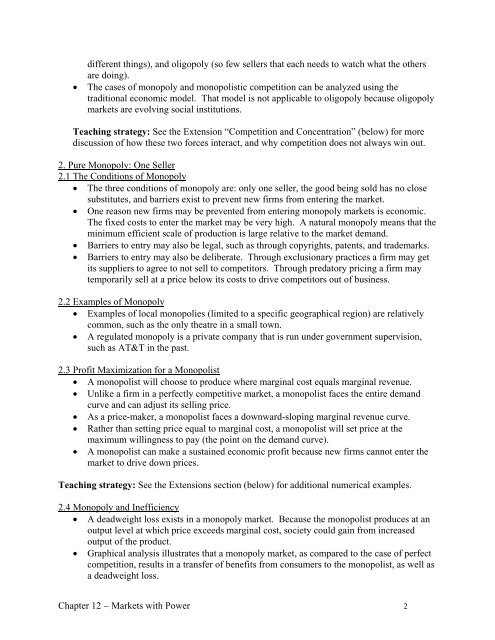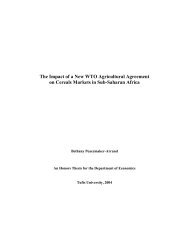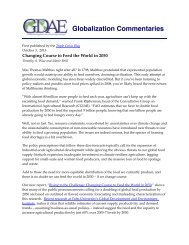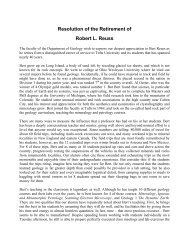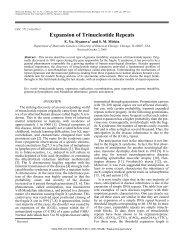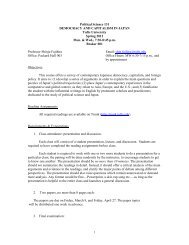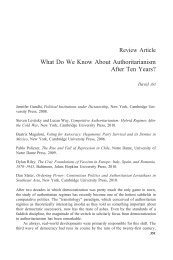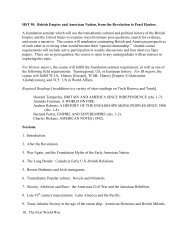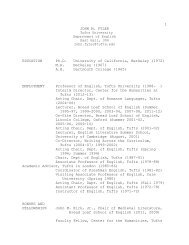MARKETS WITH MARKET POWER - Tufts University
MARKETS WITH MARKET POWER - Tufts University
MARKETS WITH MARKET POWER - Tufts University
You also want an ePaper? Increase the reach of your titles
YUMPU automatically turns print PDFs into web optimized ePapers that Google loves.
different things), and oligopoly (so few sellers that each needs to watch what the others<br />
are doing).<br />
• The cases of monopoly and monopolistic competition can be analyzed using the<br />
traditional economic model. That model is not applicable to oligopoly because oligopoly<br />
markets are evolving social institutions.<br />
Teaching strategy: See the Extension “Competition and Concentration” (below) for more<br />
discussion of how these two forces interact, and why competition does not always win out.<br />
2. Pure Monopoly: One Seller<br />
2.1 The Conditions of Monopoly<br />
• The three conditions of monopoly are: only one seller, the good being sold has no close<br />
substitutes, and barriers exist to prevent new firms from entering the market.<br />
• One reason new firms may be prevented from entering monopoly markets is economic.<br />
The fixed costs to enter the market may be very high. A natural monopoly means that the<br />
minimum efficient scale of production is large relative to the market demand.<br />
• Barriers to entry may also be legal, such as through copyrights, patents, and trademarks.<br />
• Barriers to entry may also be deliberate. Through exclusionary practices a firm may get<br />
its suppliers to agree to not sell to competitors. Through predatory pricing a firm may<br />
temporarily sell at a price below its costs to drive competitors out of business.<br />
2.2 Examples of Monopoly<br />
• Examples of local monopolies (limited to a specific geographical region) are relatively<br />
common, such as the only theatre in a small town.<br />
• A regulated monopoly is a private company that is run under government supervision,<br />
such as AT&T in the past.<br />
2.3 Profit Maximization for a Monopolist<br />
• A monopolist will choose to produce where marginal cost equals marginal revenue.<br />
• Unlike a firm in a perfectly competitive market, a monopolist faces the entire demand<br />
curve and can adjust its selling price.<br />
• As a price-maker, a monopolist faces a downward-sloping marginal revenue curve.<br />
• Rather than setting price equal to marginal cost, a monopolist will set price at the<br />
maximum willingness to pay (the point on the demand curve).<br />
• A monopolist can make a sustained economic profit because new firms cannot enter the<br />
market to drive down prices.<br />
Teaching strategy: See the Extensions section (below) for additional numerical examples.<br />
2.4 Monopoly and Inefficiency<br />
• A deadweight loss exists in a monopoly market. Because the monopolist produces at an<br />
output level at which price exceeds marginal cost, society could gain from increased<br />
output of the product.<br />
• Graphical analysis illustrates that a monopoly market, as compared to the case of perfect<br />
competition, results in a transfer of benefits from consumers to the monopolist, as well as<br />
a deadweight loss.<br />
Chapter 12 − Markets with Power 2


